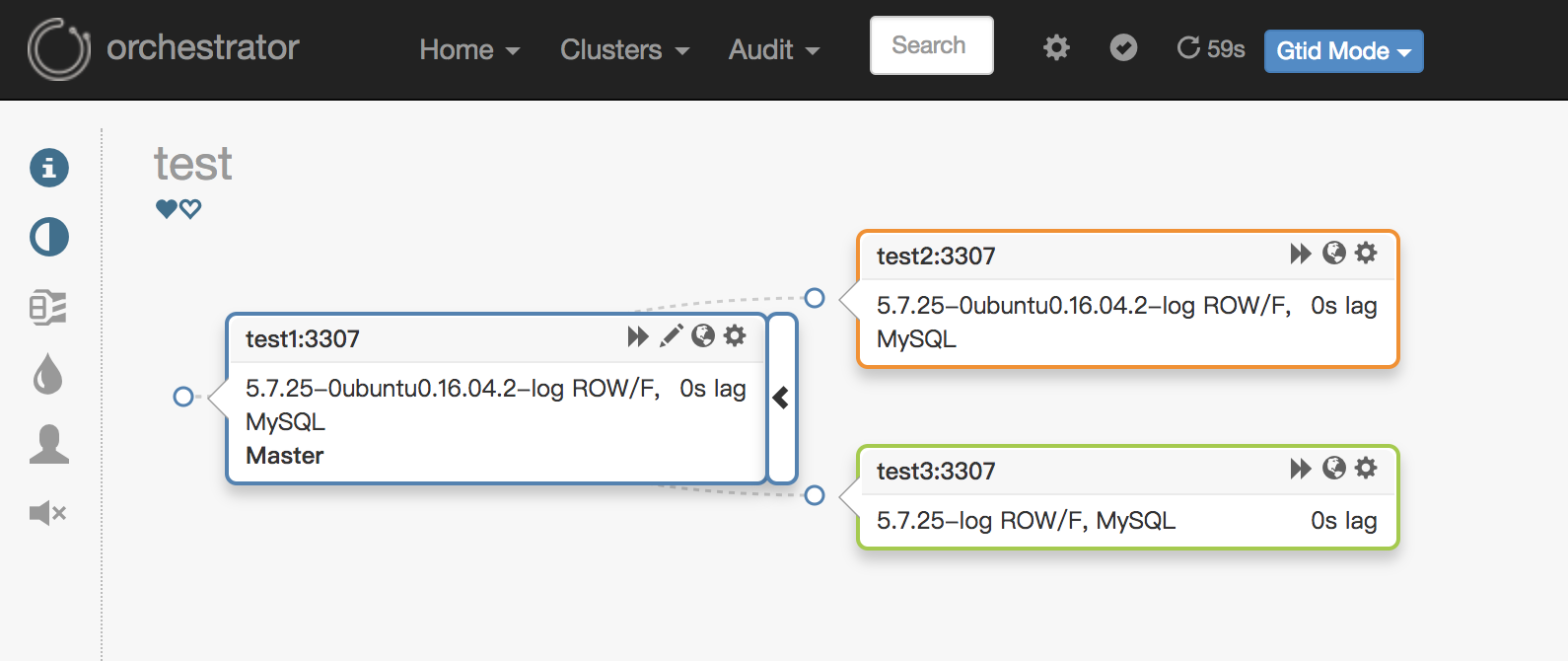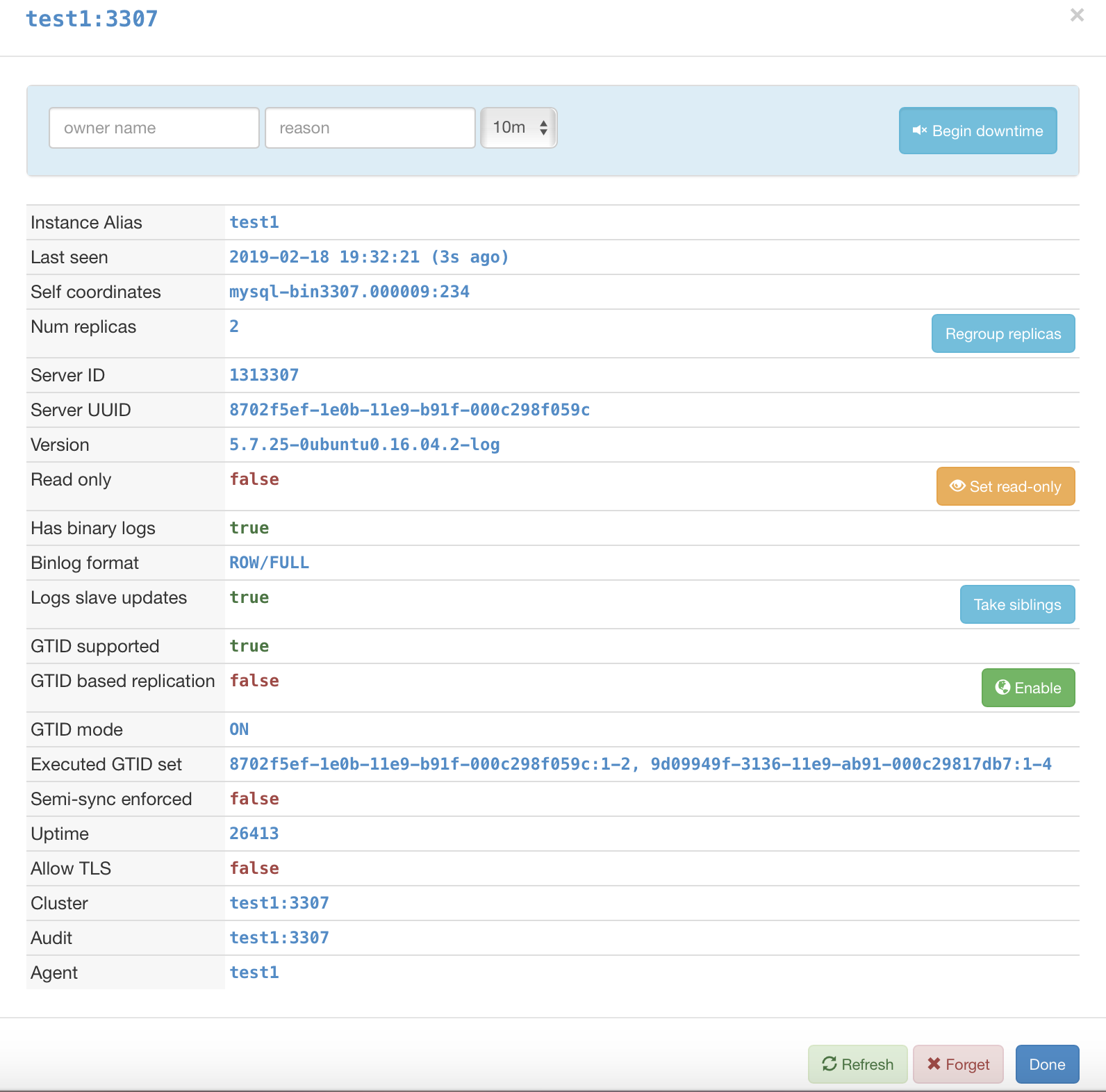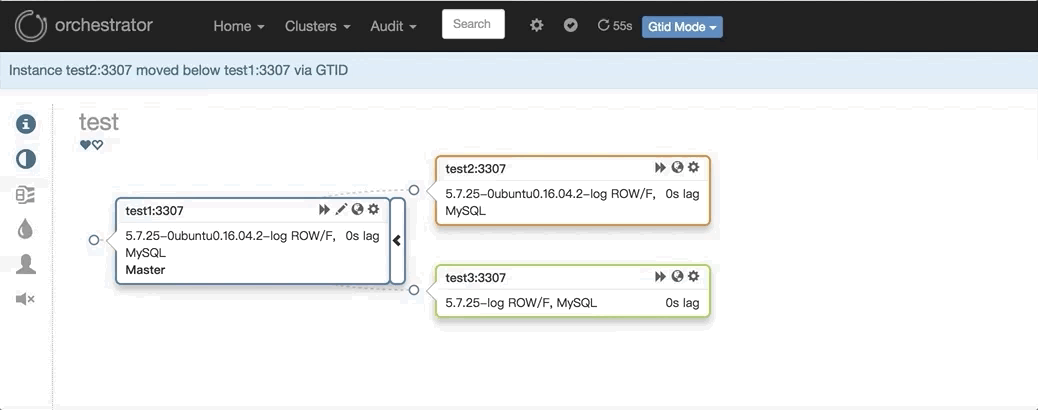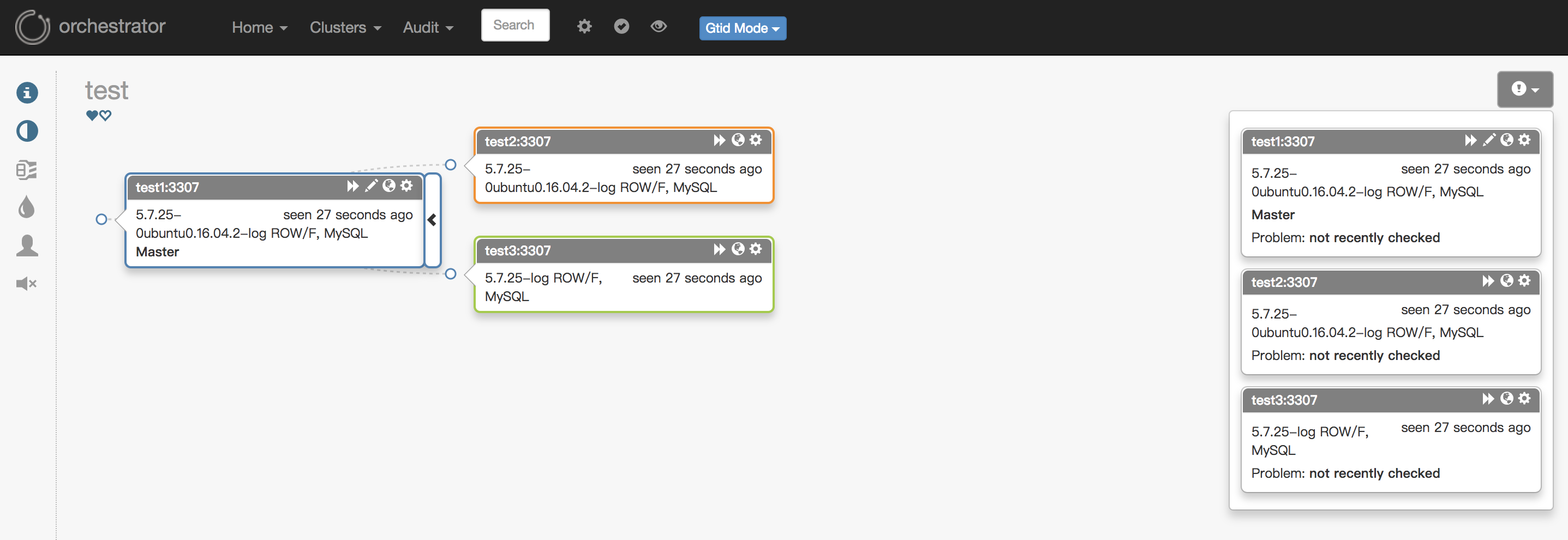MySQL高可用复制管理工具 —— Orchestrator使用
背景
在上一篇「MySQL高可用复制管理工具 —— Orchestrator介绍」中大致介绍了Orchestrator的功能、配置和部署,当然最详细的说明可以查阅官方文档。本文开始对Orchestrator的各方面进行测试和说明。
测试说明
环境介绍
服务器环境:
三台服务器
:MySQL实例(3306是orch的后端数据库,3307是MySQL主从架构「开启GTID」)
Master :192.168.163.131:
Slave :192.168.163.132:
Slave :192.168.163.133: :hosts(etc/hosts):
192.168.163.131 test1
192.168.163.132 test2
192.168.163.133 test3
这里需要注意的是,orch检测主库宕机依赖从库的IO线程(本身连不上主库后,还会通过从库再去检测主库是否异常),所以默认change搭建的主从感知主库宕机的等待时间过长,需要需要稍微改下:
change master to master_host='192.168.163.131',master_port=,master_user='rep',master_password='rep',master_auto_position=,MASTER_HEARTBEAT_PERIOD=,MASTER_CONNECT_RETRY=, MASTER_RETRY_COUNT=;
set global slave_net_timeout=;
slave_net_timeout(全局变量):MySQL5.7.7之后,默认改成60秒。该参数定义了从库从主库获取数据等待的秒数,超过这个时间从库会主动退出读取,中断连接,并尝试重连。
master_heartbeat_period:复制心跳的周期。默认是slave_net_timeout的一半。Master在没有数据的时候,每master_heartbeat_period秒发送一个心跳包,这样 Slave 就能知道 Master 是不是还正常。
slave_net_timeout是设置在多久没收到数据后认为网络超时,之后 Slave 的 IO 线程会重新连接 Master 。结合这两个设置就可以避免由于网络问题导致的复制延误。master_heartbeat_period 单位是秒,可以是个带上小数,如 10.5,最高精度为 1 毫秒。
重试策略为:
备库过了slave-net-timeout秒还没有收到主库来的数据,它就会开始第一次重试。然后每过 master-connect-retry 秒,备库会再次尝试重连主库。直到重试了 master-retry-count 次,它才会放弃重试。如果重试的过程中,连上了主库,那么它认为当前主库是好的,又会开始 slave-net-timeout 秒的等待。
slave-net-timeout 的默认值是 秒, master-connect-retry 默认为 秒, master-retry-count 默认为 次。也就是说,如果主库一分钟都没有任何数据变更发送过来,备库才会尝试重连主库。
这样,主库宕机之后,约8~10秒感知主库异常,Orchestrator开始切换。另外还需要注意的是,orch默认是用主机名来进行管理的,需要在mysql的配置文件里添加:report_host和report_port参数。
数据库环境:
Orchestrator后端数据库:
在启动Orchestrator程序的时候,会自动在数据库里创建orchestrator数据库,保存orchestrator的一些数据信息。 Orchestrator管理的数据库:
在配置文件里配置的一些query参数,需要在每个被管理的目标库里有meta库来保留一些元信息(类似cmdb功能),比如用pt-heartbeat来验证主从延迟;用cluster表来保存别名、数据中心等。
如下面是测试环境的cluster表信息:
> CREATE TABLE `cluster` (
`anchor` tinyint() NOT NULL,
`cluster_name` varchar() CHARACTER SET ascii NOT NULL DEFAULT '',
`cluster_domain` varchar() CHARACTER SET ascii NOT NULL DEFAULT '',
`data_center` varchar() NOT NULL,
PRIMARY KEY (`anchor`)
) ENGINE=InnoDB DEFAULT CHARSET=utf8 >select * from cluster;
+--------+--------------+----------------+-------------+
| anchor | cluster_name | cluster_domain | data_center |
+--------+--------------+----------------+-------------+
| | test | CaoCao | BJ |
+--------+--------------+----------------+-------------+
测试说明
开启Orchestrator进程:
./orchestrator --config=/etc/orchestrator.conf.json http
在浏览器里输入三台主机的任意主机的IP加端口(http://192.168.163.131:3000)进入到Web管理界面,在Clusters导航的Discover里输入任意一台被管理MySQL实例的信息。添加完成之后,Web界面效果:

在web上可以进行相关的管理,关于Web上的相关按钮的说明,下面会做相关说明:
1. 部分可修改的参数(点击Web上需要被修改实例的任意图标):

说明
Instance Alias :实例别名
Last seen : 最后检测时间
Self coordinates :自身的binlog位点信息
Num replicas :有几个从库
Server ID : MySQL server_id
Server UUID : MySQL UUID
Version : 版本
Read only : 是否只读
Has binary logs :是否开启binlog
Binlog format :binlog 模式
Logs slave updates :是否开启log_slave_updates
GTID supported :是否支持GTID
GTID based replication :是否是基于GTID的复制
GTID mode :复制是否开启了GTID
Executed GTID set :复制中执行过的GTID列表
Uptime :启动时间
Allow TLS :是否开启TLS
Cluster :集群别名
Audit :审计实例
Agent :Agent实例
说明:上面图中,后面有按钮的都是可以在Web上进行修改的功能,如:是否只读,是否开启GTID的复制等。其中Begin Downtime 会将实例标记为已停用,此时如果发生Failover,该实例不会参与。
2. 任意改变主从的拓扑结构:可以直接在图上拖动变更复制,会自动恢复拓扑关系:

3. 主库挂了之后自动Failover,如:

图中显示,当主挂掉之后,拓扑结构里自动剔除该主节点,选择一个最合适的从库提升成主库,并修复复制拓扑。在Failover过程当中,可以查看/tmp/recovery.log文件(配置文件里定死),里面包含了在Failover过程中Hooks执行的外部脚本,类似MHA的master_ip_failover_script参数。可以通过外部脚本进行相应的如:VIP切换、Proxy修改、DNS修改、中间件修改、LVS修改等等,具体的执行脚本可以根据自己的实际情况编写。
4. Orchestrator高可用。因为在一开始就已经部署了3台,通过配置文件里的Raft参数进行通信。只要有2个节点的Orchestrator正常,就不会影响使用,如果出现2个节点的Orchestrator异常,则Failover会失败。2个节点异常的图如下:

图中的各个节点全部显示灰色,此时Raft算法失效,导致Orch的Failover功能失败。相对比MHA的Manager的单点,Orchestrator通过Raft算法解决了本身的高可用性以及解决网络隔离问题,特别是跨数据中心网络异常。这里说明下Raft,通过共识算法:
Orchestrator节点能够选择具有仲裁的领导者(leader)。如有3个orch节点,其中一个可以成为leader(3节点仲裁大小为2,5节点仲裁大小为3)。只允许leader进行修改,每个MySQL拓扑服务器将由三个不同的orchestrator节点独立访问,在正常情况下,三个节点将看到或多或少相同的拓扑图,但他们每个都会独立分析写入其自己的专用后端数据库服务器:
① 所有更改都必须通过leader。
② 在启用raft模式上禁止使用orchestrator客户端。
③ 在启用raft模式上使用orchestrator-client,orchestrator-client可以安装在没有orchestrator上的服务器。
④ 单个orchestrator节点的故障不会影响orchestrator的可用性。在3节点设置上,最多一个服务器可能会失败。在5节点设置上,2个节点可能会失败。
⑤ Orchestrator节点异常关闭,然后再启动。它将重新加入Raft组,并接收遗漏的任何事件,只要有足够的Raft记录。
⑥ 要加入比日志保留允许的更长/更远的orchestrator节点或者数据库完全为空的节点,需要从另一个活动节点克隆后端DB。
关于Raft更多的信息见:https://github.com/github/orchestrator/blob/master/docs/raft.md
Orchestrator的高可用有2种方式,第一种就是上面说的通过Raft(推荐),另一种是通过后端数据库的同步。详细信息见文档。文档里详细比较了两种高可用性部署方法。两种方法的图如下:

到这里,Orchestrator的基本功能已经实现,包括主动Failover、修改拓扑结构以及Web上的可视化操作。
5. Web上各个按钮的功能说明
①:Home下的status:查看orch的状态:包括运行时间、版本、后端数据库以及各个Raft节点的状态。
②:Cluster下的dashboard:查看orch下的所有被管理的MySQL实例。
③:Cluster下的Failure analysis:查看故障分析以及包括记录的故障类型列表。
④:Cluster下的Discover:用来发现被管理的MySQL实例。
⑤:Audit下的Failure detection:故障检测信息,包含历史信息。
⑥:Audit下的Recovery:故障恢复信息以及故障确认。
⑦:Audit下的Agent:是一个在MySQL主机上运行并与orchestrator通信的服务,能够向orch提供操作系统,文件系统和LVM信息,以及调用某些命令和脚本。
⑧:导航栏里的 图标,对应左边导航栏的图标:
图标,对应左边导航栏的图标:
第1行:集群别名的查看修改。
第2行:pools。
第3行:Compact display,紧凑展示。
第4行:Pool indicator,池指示器。
第5行:Colorize DC,每个数据中心用不同颜色展示。
第6行:Anonymize,匿名集群中的主机名。
注意:左边导航栏里的 图标,表示实例的概括:实例名、别名、故障检测和恢复等信息。
图标,表示实例的概括:实例名、别名、故障检测和恢复等信息。
⑧:导航栏里的 图标,表示是否禁止全局恢复。禁止掉的话不会进行Failover。
图标,表示是否禁止全局恢复。禁止掉的话不会进行Failover。
⑨:导航栏里的 图标,表示是否开启刷新页面(默认60一次)。
图标,表示是否开启刷新页面(默认60一次)。
⑩:导航栏里的 图标,表示MySQL实例迁移模式。
图标,表示MySQL实例迁移模式。
Smart mode:自动选择迁移模式,让Orch自己选择迁移模式。
Classic mode:经典迁移模式,通过binlog和position进行迁移。
GTID mode:GTID迁移模式。
Pseudo GTID mode:伪GTID迁移模式。
到此,Orchestrator的基本测试和Web说明已经介绍完毕。和MHA比已经有很大的体验提升,不仅在Web进行部分参数的设置修改,还可以改变复制拓扑,最重要的是解决MHA Manager单点的问题。还有什么理由不替换MHA呢?:)
工作流程说明
Orchestrator实现了自动Failover,现在来看看自动Failover的大致流程是怎么样的。
1. 检测流程
① orchestrator利用复制拓扑,先检查主本身,并观察其slaves。
② 如果orchestrator本身连不上主,可以连上该主的从,则通过从去检测,若在从上也看不到主(IO Thread)「2次检查」,判断Master宕机。
该检测方法比较合理,当从都连不上主了,则复制肯定有出问题,故会进行切换。所以在生产中非常可靠。
检测发生故障后并不都会进行自动恢复,比如:禁止全局恢复、设置了shutdown time、上次恢复离本次恢复时间在RecoveryPeriodBlockSeconds设置的时间内、失败类型不被认为值得恢复等。检测与恢复无关,但始终启用。 每次检测都会执行OnFailureDetectionProcesses Hooks。
{
"FailureDetectionPeriodBlockMinutes": ,
}
Hooks相关参数:
{
"OnFailureDetectionProcesses": [
"echo 'Detected {failureType} on {failureCluster}. Affected replicas: {countReplicas}' >> /tmp/recovery.log"
],
}
MySQL复制相关调整:
slave_net_timeout
MASTER_CONNECT_RETRY
2. 恢复流程
恢复的实例需要支持:GTID、伪GTID、开启Binlog。恢复的配置如下:
{
"RecoveryPeriodBlockSeconds": ,
"RecoveryIgnoreHostnameFilters": [],
"RecoverMasterClusterFilters": [
"thiscluster",
"thatcluster"
],
"RecoverMasterClusterFilters": ["*"],
"RecoverIntermediateMasterClusterFilters": [
"*"
],
}
{
"ApplyMySQLPromotionAfterMasterFailover": true,
"PreventCrossDataCenterMasterFailover": false,
"FailMasterPromotionIfSQLThreadNotUpToDate": true,
"MasterFailoverLostInstancesDowntimeMinutes": ,
"DetachLostReplicasAfterMasterFailover": true,
}
Hooks:
{
"PreGracefulTakeoverProcesses": [
"echo 'Planned takeover about to take place on {failureCluster}. Master will switch to read_only' >> /tmp/recovery.log"
],
"PreFailoverProcesses": [
"echo 'Will recover from {failureType} on {failureCluster}' >> /tmp/recovery.log"
],
"PostFailoverProcesses": [
"echo '(for all types) Recovered from {failureType} on {failureCluster}. Failed: {failedHost}:{failedPort}; Successor: {successorHost}:{successorPort}' >> /tmp/recovery.log"
],
"PostUnsuccessfulFailoverProcesses": [],
"PostMasterFailoverProcesses": [
"echo 'Recovered from {failureType} on {failureCluster}. Failed: {failedHost}:
{failedPort}; Promoted: {successorHost}:{successorPort}' >> /tmp/recovery.log"
],
"PostIntermediateMasterFailoverProcesses": [],
"PostGracefulTakeoverProcesses": [
"echo 'Planned takeover complete' >> /tmp/recovery.log"
],
}
具体的参数含义请参考「MySQL高可用复制管理工具 —— Orchestrator介绍」。在执行故障检测和恢复的时候都可以执行外部自定义脚本(hooks),来配合使用(VIP、Proxy、DNS)。
可以恢复中继主库(DeadIntermediateMaster)和主库:
中继主库:恢复会找其同级的节点进行做主从。匹配副本按照哪些实例具有log-slave-updates、实例是否延迟、它们是否具有复制过滤器、哪些版本的MySQL等等
主库:恢复可以指定提升特定的从库「提升规则」(register-candidate),提升的从库不一定是最新的,而是选择最合适的,设置完提升规则之后,有效期为1个小时。
提升规则选项有:
prefer --比较喜欢
neutral --中立(默认)
prefer_not --比较不喜欢
must_not --拒绝
恢复支持的类型有:自动恢复、优雅的恢复、手动恢复、手动强制恢复,恢复的时候也可以执行相应的Hooks参数。具体的恢复流程可以看恢复流程的说明。关于恢复的配置可以官方说明。
补充:每次恢复除了自动的Failover之外,都需要配合执行自己定义的Hooks的脚本来处理外部的一些操作:VIP修改、DNS修改、Proxy修改等等。所以这么多Hooks的参数该如何设置呢?哪个参数需要执行,哪个参数不需要执行,以及Hooks的执行顺序是怎么样的?虽然文章里有介绍,但为了更好的进行说明,下面进行各种恢复场景执行Hooks的顺序:
"OnFailureDetectionProcesses": [ #检测故障时执行
"echo '② Detected {failureType} on {failureCluster}. Affected replicas: {countSlaves}' >> /tmp/recovery.log"
],
"PreGracefulTakeoverProcesses": [ #在主变为只读之前立即执行
"echo '① Planned takeover about to take place on {failureCluster}. Master will switch to read_only' >> /tmp/recovery.log"
],
"PreFailoverProcesses": [ #在执行恢复操作之前立即执行
"echo '③ Will recover from {failureType} on {failureCluster}' >> /tmp/recovery.log"
],
"PostMasterFailoverProcesses": [ #在主恢复成功结束时执行
"echo '④ Recovered from {failureType} on {failureCluster}. Failed: {failedHost}:{failedPort}; Promoted: {successorHost}:{successorPort}' >> /tmp/recovery.log"
],
"PostFailoverProcesses": [ #在任何成功恢复结束时执行
"echo '⑤ (for all types) Recovered from {failureType} on {failureCluster}. Failed: {failedHost}:{failedPort}; Successor: {successorHost}:{successorPort}' >> /tmp/recovery.log"
],
"PostUnsuccessfulFailoverProcesses": [ #在任何不成功的恢复结束时执行
"echo '⑧ >> /tmp/recovery.log'"
],
"PostIntermediateMasterFailoverProcesses": [ #在成功的中间主恢复结束时执行
"echo '⑥ Recovered from {failureType} on {failureCluster}. Failed: {failedHost}:{failedPort}; Successor: {successorHost}:{successorPort}' >> /tmp/recovery.log"
],
"PostGracefulTakeoverProcesses": [ #在旧主位于新晋升的主之后执行
"echo '⑦ Planned takeover complete' >> /tmp/recovery.log"
],
主库宕机,自动Failover
② Detected UnreachableMaster on test1:. Affected replicas:
② Detected DeadMaster on test1:. Affected replicas:
③ Will recover from DeadMaster on test1:
④ Recovered from DeadMaster on test1:. Failed: test1:; Promoted: test2:
⑤ (for all types) Recovered from DeadMaster on test1:. Failed: test1:; Successor: test2: 优雅的主从切换:test2:3307优雅的切换到test1:,切换之后需要手动执行start slave
orchestrator-client -c graceful-master-takeover -a test2: -d test1:
① Planned takeover about to take place on test2:. Master will switch to read_only
② Detected DeadMaster on test2:. Affected replicas:
③ Will recover from DeadMaster on test2:
④ Recovered from DeadMaster on test2:. Failed: test2:; Promoted: test1:
⑤ (for all types) Recovered from DeadMaster on test2:. Failed: test2:; Successor: test1:
⑦ Planned takeover complete 手动恢复,当从库进入停机或则维护模式,此时主库宕机,不会自动Failover,需要手动执行恢复,指定死掉的主实例:
orchestrator-client -c recover -i test1:
② Detected UnreachableMaster on test1:. Affected replicas:
② Detected DeadMaster on test1:. Affected replicas:
③ Will recover from DeadMaster on test1:
④ Recovered from DeadMaster on test1:. Failed: test1:; Promoted: test2:
⑤ (for all types) Recovered from DeadMaster on test1:. Failed: test1:; Successor: test2: 手动强制恢复,不管任何情况,都进行恢复:
orchestrator-client -c force-master-failover -i test2:
② Detected DeadMaster on test2:. Affected replicas:
③ Will recover from DeadMaster on test2:
② Detected AllMasterSlavesNotReplicating on test2:. Affected replicas:
④ Recovered from DeadMaster on test2:. Failed: test2:; Promoted: test1:
⑤ (for all types) Recovered from DeadMaster on test2:. Failed: test2:; Successor: test1:
其中上面的情况下,⑥和⑧都没执行。因为⑥是执行中间主库时候执行的,没有中间主库(级联复制)可以不用设置。⑧是恢复失败的时候执行的,上面恢复没有出现失败,可以定义一些告警提醒。
生产环境上部署
在生产上部署Orchestrator,可以参考文档。
1. Orchestrator首先需要确认本身高可用的后端数据库是用单个MySQL,MySQL复制还是本身的Raft。
2. 运行发现服务(web、orchestrator-client)
orchestrator-client -c discover -i this.hostname.com
3. 确定提升规则(某些服务器更适合被提升)
orchestrator -c register-candidate -i ${::fqdn} --promotion-rule ${promotion_rule}
4. 如果服务器出现问题,将在Web界面上的问题下拉列表中显示。使用Downtiming则不会在问题列表里显示,并且也不会进行恢复,处于维护模式。
orchestrator -c begin-downtime -i ${::fqdn} --duration=5m --owner=cron --reason=continuous_downtime"
也可以用API:
curl -s "http://my.orchestrator.service:80/api/begin-downtime/my.hostname/3306/wallace/experimenting+failover/45m"
5. 伪GTID,如果MySQL没有开启GTID,则可以开启伪GTID实现类似GTID的功能。
6. 保存元数据,元数据大部分通过参数的query来获取,比如在自的表cluster里获取集群的别名(DetectClusterAliasQuery)、数据中心(DetectDataCenterQuery)、域名(DetectClusterDomainQuery)等,以及复制的延迟(pt-heartbeat)、是否半同步(DetectSemiSyncEnforcedQuery)。以及可以通过正则匹配:DataCenterPattern、PhysicalEnvironmentPattern等。
7. 可以给实例打标签。
命令行、API的使用
Orchestrator不仅有Web界面来进行查看和管理,还可以通过命令行(orchestrator-client)和API(curl)来执行更多的管理命令,现在来说明几个比较常用方法。
通过help来看下有哪些可以执行的命令:./orchestrator-client --help,命令的说明可以看手册说明。
Usage: orchestrator-client -c <command> [flags...]
Example: orchestrator-client -c which-master -i some.replica
Options: -h, --help
print this help
-c <command>, --command <command>
indicate the operation to perform (see listing below)
-a <alias>, --alias <alias>
cluster alias
-o <owner>, --owner <owner>
name of owner for downtime/maintenance commands
-r <reason>, --reason <reason>
reason for downtime/maintenance operation
-u <duration>, --duration <duration>
duration for downtime/maintenance operations
-R <promotion rule>, --promotion-rule <promotion rule>
rule for 'register-candidate' command
-U <orchestrator_api>, --api <orchestrator_api>
override $orchestrator_api environemtn variable,
indicate where the client should connect to.
-P <api path>, --path <api path>
With '-c api', indicate the specific API path you wish to call
-b <username:password>, --auth <username:password>
Specify when orchestrator uses basic HTTP auth.
-q <query>, --query <query>
Indicate query for 'restart-replica-statements' command
-l <pool name>, --pool <pool name>
pool name for pool related commands
-H <hostname> -h <hostname>
indicate host for resolve and raft operations help Show available commands
which-api Output the HTTP API to be used
api Invoke any API request; provide --path argument
async-discover Lookup an instance, investigate it asynchronously. Useful for bulk loads
discover Lookup an instance, investigate it
forget Forget about an instance's existence
forget-cluster Forget about a cluster
topology Show an ascii-graph of a replication topology, given a member of that topology
topology-tabulated Show an ascii-graph of a replication topology, given a member of that topology, in tabulated format
clusters List all clusters known to orchestrator
clusters-alias List all clusters known to orchestrator
search Search for instances matching given substring
instance"|"which-instance Output the fully-qualified hostname:port representation of the given instance, or error if unknown
which-master Output the fully-qualified hostname:port representation of a given instance's master
which-replicas Output the fully-qualified hostname:port list of replicas of a given instance
which-broken-replicas Output the fully-qualified hostname:port list of broken replicas of a given instance
which-cluster-instances Output the list of instances participating in same cluster as given instance
which-cluster Output the name of the cluster an instance belongs to, or error if unknown to orchestrator
which-cluster-master Output the name of a writable master in given cluster
all-clusters-masters List of writeable masters, one per cluster
all-instances The complete list of known instances
which-cluster-osc-replicas Output a list of replicas in a cluster, that could serve as a pt-online-schema-change operation control replicas
which-cluster-osc-running-replicas Output a list of healthy, replicating replicas in a cluster, that could serve as a pt-online-schema-change operation control replicas
downtimed List all downtimed instances
dominant-dc Name the data center where most masters are found
submit-masters-to-kv-stores Submit a cluster's master, or all clusters' masters to KV stores
relocate Relocate a replica beneath another instance
relocate-replicas Relocates all or part of the replicas of a given instance under another instance
match Matches a replica beneath another (destination) instance using Pseudo-GTID
match-up Transport the replica one level up the hierarchy, making it child of its grandparent, using Pseudo-GTID
match-up-replicas Matches replicas of the given instance one level up the topology, making them siblings of given instance, using Pseudo-GTID
move-up Move a replica one level up the topology
move-below Moves a replica beneath its sibling. Both replicas must be actively replicating from same master.
move-equivalent Moves a replica beneath another server, based on previously recorded "equivalence coordinates"
move-up-replicas Moves replicas of the given instance one level up the topology
make-co-master Create a master-master replication. Given instance is a replica which replicates directly from a master.
take-master Turn an instance into a master of its own master; essentially switch the two.
move-gtid Move a replica beneath another instance via GTID
move-replicas-gtid Moves all replicas of a given instance under another (destination) instance using GTID
repoint Make the given instance replicate from another instance without changing the binglog coordinates. Use with care
repoint-replicas Repoint all replicas of given instance to replicate back from the instance. Use with care
take-siblings Turn all siblings of a replica into its sub-replicas.
tags List tags for a given instance
tag-value List tags for a given instance
tag Add a tag to a given instance. Tag in "tagname" or "tagname=tagvalue" format
untag Remove a tag from an instance
untag-all Remove a tag from all matching instances
tagged List instances tagged by tag-string. Format: "tagname" or "tagname=tagvalue" or comma separated "tag0,tag1=val1,tag2" for intersection of all.
submit-pool-instances Submit a pool name with a list of instances in that pool
which-heuristic-cluster-pool-instances List instances of a given cluster which are in either any pool or in a specific pool
begin-downtime Mark an instance as downtimed
end-downtime Indicate an instance is no longer downtimed
begin-maintenance Request a maintenance lock on an instance
end-maintenance Remove maintenance lock from an instance
register-candidate Indicate the promotion rule for a given instance
register-hostname-unresolve Assigns the given instance a virtual (aka "unresolved") name
deregister-hostname-unresolve Explicitly deregister/dosassociate a hostname with an "unresolved" name
stop-replica Issue a STOP SLAVE on an instance
stop-replica-nice Issue a STOP SLAVE on an instance, make effort to stop such that SQL thread is in sync with IO thread (ie all relay logs consumed)
start-replica Issue a START SLAVE on an instance
restart-replica Issue STOP and START SLAVE on an instance
reset-replica Issues a RESET SLAVE command; use with care
detach-replica Stops replication and modifies binlog position into an impossible yet reversible value.
reattach-replica Undo a detach-replica operation
detach-replica-master-host Stops replication and modifies Master_Host into an impossible yet reversible value.
reattach-replica-master-host Undo a detach-replica-master-host operation
skip-query Skip a single statement on a replica; either when running with GTID or without
gtid-errant-reset-master Remove errant GTID transactions by way of RESET MASTER
gtid-errant-inject-empty Apply errant GTID as empty transactions on cluster's master
enable-semi-sync-master Enable semi-sync (master-side)
disable-semi-sync-master Disable semi-sync (master-side)
enable-semi-sync-replica Enable semi-sync (replica-side)
disable-semi-sync-replica Disable semi-sync (replica-side)
restart-replica-statements Given `-q "<query>"` that requires replication restart to apply, wrap query with stop/start slave statements as required to restore instance to same replication state. Print out set of statements
can-replicate-from Check if an instance can potentially replicate from another, according to replication rules
can-replicate-from-gtid Check if an instance can potentially replicate from another, according to replication rules and assuming Oracle GTID
is-replicating Check if an instance is replicating at this time (both SQL and IO threads running)
is-replication-stopped Check if both SQL and IO threads state are both strictly stopped.
set-read-only Turn an instance read-only, via SET GLOBAL read_only :=
set-writeable Turn an instance writeable, via SET GLOBAL read_only :=
flush-binary-logs Flush binary logs on an instance
last-pseudo-gtid Dump last injected Pseudo-GTID entry on a server
recover Do auto-recovery given a dead instance, assuming orchestrator agrees there's a problem. Override blocking.
graceful-master-takeover Gracefully promote a new master. Either indicate identity of new master via '-d designated.instance.com' or setup replication tree to have a single direct replica to the master.
force-master-failover Forcibly discard master and initiate a failover, even if orchestrator doesn't see a problem. This command lets orchestrator choose the replacement master
force-master-takeover Forcibly discard master and promote another (direct child) instance instead, even if everything is running well
ack-cluster-recoveries Acknowledge recoveries for a given cluster; this unblocks pending future recoveries
ack-all-recoveries Acknowledge all recoveries
disable-global-recoveries Disallow orchestrator from performing recoveries globally
enable-global-recoveries Allow orchestrator to perform recoveries globally
check-global-recoveries Show the global recovery configuration
replication-analysis Request an analysis of potential crash incidents in all known topologies
raft-leader Get identify of raft leader, assuming raft setup
raft-health Whether node is part of a healthy raft group
raft-leader-hostname Get hostname of raft leader, assuming raft setup
raft-elect-leader Request raft re-elections, provide hint for new leader's identity
orchestrator-client不需要和Orchestrator服务放一起,不需要访问后端数据库,在任意一台上都可以。
注意:因为配置了Raft,有多个Orchestrator,所以需要ORCHESTRATOR_API的环境变量,orchestrator-client会自动选择leader。如:
export ORCHESTRATOR_API="test1:3000/api test2:3000/api test3:3000/api"
1. 列出所有集群:clusters
默认:
# orchestrator-client -c clusters
test2:
返回包含集群别名:clusters-alias
# orchestrator-client -c clusters-alias
test2:,test
2. 发现指定实例:discover/async-discover
同步发现:
# orchestrator-client -c discover -i test1:
test1:
异步发现:适用于批量
# orchestrator-client -c async-discover -i test1:
:null
3. 忘记指定对象:forget/forget-cluster
忘记指定实例:
# orchestrator-client -c forget -i test1:
忘记指定集群:
# orchestrator-client -c forget-cluster -i test
4. 打印指定集群的拓扑:topology/topology-tabulated
普通返回:
# orchestrator-client -c topology -i test1:
test2: [0s,ok,5.7.-0ubuntu0.16.04.-log,rw,ROW,>>,GTID]
+ test1: [0s,ok,5.7.-0ubuntu0.16.04.-log,ro,ROW,>>,GTID]
+ test3: [0s,ok,5.7.-log,ro,ROW,>>,GTID]
列表返回:
# orchestrator-client -c topology-tabulated -i test1:
test2: |0s|ok|5.7.-0ubuntu0.16.04.-log|rw|ROW|>>,GTID
+ test1:|0s|ok|5.7.-0ubuntu0.16.04.-log|ro|ROW|>>,GTID
+ test3:|0s|ok|5.7.-log |ro|ROW|>>,GTID
5. 查看使用哪个API:自己会选择出leader。which-api
# orchestrator-client -c which-api
test3:/api
也可以通过 http://192.168.163.133:3000/api/leader-check 查看。
6. 调用api请求,需要和 -path 参数一起:api..-path
# orchestrator-client -c api -path clusters
[ "test2:3307" ]
# orchestrator-client -c api -path leader-check
"OK"
# orchestrator-client -c api -path status
{ "Code": "OK", "Message": "Application node is healthy"...}
7. 搜索实例:search
# orchestrator-client -c search -i test
test2:
test1:
test3:
8. 打印指定实例的主库:which-master
# orchestrator-client -c which-master -i test1:
test2:
# orchestrator-client -c which-master -i test3:
test2:
# orchestrator-client -c which-master -i test2:3307 #自己本身是主库
:
9. 打印指定实例的从库:which-replicas
# orchestrator-client -c which-replicas -i test2:
test1:
test3:
10. 打印指定实例的实例名:which-instance
# orchestrator-client -c instance -i test1:
test1:
11. 打印指定主实例从库异常的列表:which-broken-replicas,模拟test3的复制异常:
# orchestrator-client -c which-broken-replicas -i test2:
test3:
12. 给出一个实例或则集群别名,打印出该实例所在集群下的所有其他实例。which-cluster-instances
# orchestrator-client -c which-cluster-instances -i test
test1:
test2:
test3:
root@test1:~# orchestrator-client -c which-cluster-instances -i test1:
test1:
test2:
test3:
13. 给出一个实例,打印该实的集群名称:默认是hostname:port。which-cluster
# orchestrator-client -c which-cluster -i test1:
test2:# orchestrator-client -c which-cluster -i test2:
test2:# orchestrator-client -c which-cluster -i test3:
test2:
14. 打印出指定实例/集群名或则所有所在集群的可写实例,:which-cluster-master
指定实例:which-cluster-master
# orchestrator-client -c which-cluster-master -i test2:
test2:
# orchestrator-client -c which-cluster-master -i test
test2:
所有实例:all-clusters-masters,每个集群返回一个
# orchestrator-client -c all-clusters-masters
test1:
15. 打印出所有实例:all-instances
# orchestrator-client -c all-instances
test2:
test1:
test3:
16. 打印出集群中可以作为pt-online-schema-change操作的副本列表:which-cluster-osc-replicas
~# orchestrator-client -c which-cluster-osc-replicas -i test
test1:
test3:
root@test1:~# orchestrator-client -c which-cluster-osc-replicas -i test2:
test1:
test3:
17. 打印出集群中可以作为pt-online-schema-change可以操作的健康的副本列表:which-cluster-osc-running-replicas
# orchestrator-client -c which-cluster-osc-running-replicas -i test
test1:
test3:
# orchestrator-client -c which-cluster-osc-running-replicas -i test1:
test1:
test3:
18. 打印出所有在维护(downtimed)的实例:downtimed
# orchestrator-client -c downtimed
test1:
test3:
19. 打印出进群中主的数据中心:dominant-dc
# orchestrator-client -c dominant-dc
BJ
20. 将集群的主提交到KV存储。submit-masters-to-kv-stores
# orchestrator-client -c submit-masters-to-kv-stores
mysql/master/test:test2:
mysql/master/test/hostname:test2
mysql/master/test/port:
mysql/master/test/ipv4:192.168.163.132
mysql/master/test/ipv6:
21. 迁移从库到另一个实例上:relocate
# orchestrator-client -c relocate -i test3: -d test1:3307 #迁移test3:3307作为test1:3307的从库
test3:<test1: 查看
# orchestrator-client -c topology -i test2:
test2: [0s,ok,5.7.-0ubuntu0.16.04.-log,rw,ROW,>>,GTID]
+ test1: [0s,ok,5.7.-0ubuntu0.16.04.-log,ro,ROW,>>,GTID]
+ test3: [0s,ok,5.7.-log,ro,ROW,>>,GTID]
22. 迁移一个实例的所有从库到另一个实例上:relocate-replicas
# orchestrator-client -c relocate-replicas -i test1: -d test2:3307 #迁移test1:3307下的所有从库到test2:3307下,并列出被迁移的从库的实例名
test3:
23. 将slave在拓扑上向上移动一级,对应web上的是在Classic Model下进行拖动:move-up
# orchestrator-client -c move-up -i test3: -d test2:
test3:<test2:
结构从 test2:3307 -> test1:3307 -> test3:3307 变成 test2:3307 -> test1:3307
-> test3:3307
24. 将slave在拓扑上向下移动一级(移到同级的下面),对应web上的是在Classic Model下进行拖动:move-below
# orchestrator-client -c move-below -i test3: -d test1:
test3:<test1:
结构从 test2:3307 -> test1:3307 变成 test2:3307 -> test1:3307 -> test3:3307
-> test3:3307
25. 将给定实例的所有从库在拓扑上向上移动一级,基于Classic Model模式:move-up-replicas
# orchestrator-client -c move-up-replicas -i test1:3307
test3:
结构从 test2:3307 -> test1:3307 -> test3:3307 变成 test2:3307 -> test1:3307
-> test3:3307
26. 创建主主复制,将给定实例直接和当前主库做成主主复制:make-co-master
# orchestrator-client -c make-co-master -i test1:
test1:<test2:
27.将实例转换为自己主人的主人,切换两个:take-master
# orchestrator-client -c take-master -i test3:
test3:<test2:
结构从 test2:3307 -> test1:3307 -> test3:3307 变成 test2:3307 -> test3:3307 -> test1:3307
28. 通过GTID移动副本,move-gtid:
通过orchestrator-client执行报错:
# orchestrator-client -c move-gtid -i test3: -d test1:
parse error: Invalid numeric literal at line , column
parse error: Invalid numeric literal at line , column
parse error: Invalid numeric literal at line , column
通过orchestrator执行是没问题,需要添加--ignore-raft-setup参数:
# orchestrator -c move-gtid -i test3: -d test2: --ignore-raft-setup
test3:<test2:
29.通过GTID移动指定实例下的所有slaves到另一个实例,move-replicas-gtid
通过orchestrator-client执行报错:
# orchestrator-client -c move-replicas-gtid -i test3: -d test1:
jq: error (at <stdin>:): Cannot index string with string "Key"
通过orchestrator执行是没问题,需要添加--ignore-raft-setup参数:
# ./orchestrator -c move-replicas-gtid -i test2: -d test1: --ignore-raft-setup
test3:
30. 将给定实例的同级slave,变更成他的slave,take-siblings
# orchestrator-client -c take-siblings -i test3:
test3:<test1:
结构从 test1:3307 -> test2:3307 变成 test1:3307 -> test3:3307 -> test2:3307
-> test3:3307
31. 给指定实例打上标签,tag
# orchestrator-client -c tag -i test1: --tag 'name=AAA'
test1:
32. 列出指定实例的标签,tags:
# orchestrator-client -c tags -i test1:
name=AAA
33. 列出给定实例的标签值:tag-value
# orchestrator-client -c tag-value -i test1: --tag "name"
AAA
34. 移除指定实例上的标签:untag
# orchestrator-client -c untag -i test1: --tag "name=AAA"
test1:
35. 列出打过某个标签的实例,tagged:
# orchestrator-client -c tagged -t name
test3:
test1:
test2:
36. 标记指定实例进入停用模式,包括时间、操作人、和原因,begin-downtime:
# orchestrator-client -c begin-downtime -i test1: -duration=10m -owner=zjy -reason 'test'
test1:
37. 移除指定实例的停用模式,end--downtime:
# orchestrator-client -c end-downtime -i test1:
test1:
38. 请求指定实例上的维护锁:拓扑更改需要将锁放在最小受影响的实例上,以避免在同一个实例上发生两个不协调的操作,begin-maintenance :
# orchestrator-client -c begin-maintenance -i test1: --reason "XXX"
test1:
锁默认10分钟后过期,有参数MaintenanceExpireMinutes。
39. 移除指定实例上的维护锁:end-maintenance
# orchestrator-client -c end-maintenance -i test1:
test1:
40. 设置提升规则,恢复时可以指定一个实例进行提升:register-candidate:需要和promotion-rule一起使用
# orchestrator-client -c register-candidate -i test3: --promotion-rule prefer
test3:
提升test3:3307的权重,如果进行Failover,会成为Master。
41. 指定实例执行停止复制:
普通的:stop slave:stop-replica
# orchestrator-client -c stop-replica -i test2:
test2:
应用完relay log,在stop slave:stop-replica-nice
# orchestrator-client -c stop-replica-nice -i test2:
test2:
42.指定实例执行开启复制: start-replica
# orchestrator-client -c start-replica -i test2:
test2:
43. 指定实例执行复制重启:restart-replica
# orchestrator-client -c restart-replica -i test2:
test2:
44.指定实例执行复制重置:reset-replica
# orchestrator-client -c reset-replica -i test2:
test2:
45.分离副本:非GTID修改binlog position,detach-replica :
# orchestrator-client -c detach-replica -i test2:
46.恢复副本:reattach-replica
# orchestrator-client -c reattach-replica -i test2:
47.分离副本:注释master_host来分离,detach-replica-master-host :如Master_Host: //test1
# orchestrator-client -c detach-replica-master-host -i test2:
test2:
48. 恢复副本:reattach-replica-master-host
# orchestrator-client -c reattach-replica-master-host -i test2:
test2:
49. 跳过SQL线程的Query,如主键冲突,支持在GTID和非GTID下:skip-query
# orchestrator-client -c skip-query -i test2:
test2:
50. 将错误的GTID事务当做空事务应用副本的主上:gtid-errant-inject-empty「web上的fix」
# orchestrator-client -c gtid-errant-inject-empty -i test2:
test2:
51. 通过RESET MASTER删除错误的GTID事务:gtid-errant-reset-master
# orchestrator-client -c gtid-errant-reset-master -i test2:
test2:
52. 设置半同步相关的参数:
orchestrator-client -c $variable -i test1:
enable-semi-sync-master 主上执行开启半同步
disable-semi-sync-master 主上执行关闭半同步
enable-semi-sync-replica 从上执行开启半同步
disable-semi-sync-replica 从上执行关闭半同步
53. 执行需要stop/start slave配合的SQL:restart-replica-statements
# orchestrator-client -c restart-replica-statements -i test3: -query "change master to auto_position=1" | jq .[] -r
stop slave io_thread;
stop slave sql_thread;
change master to auto_position=;
start slave sql_thread;
start slave io_thread; # orchestrator-client -c restart-replica-statements -i test3: -query "change master to master_auto_position=1" | jq .[] -r | mysql -urep -p -htest3 -P3307
Enter password:
54.根据复制规则检查实例是否可以从另一个实例复制(GTID和非GTID):
非GTID,can-replicate-from:
# orchestrator-client -c can-replicate-from -i test3: -d test1:
test1:
GTID:can-replicate-from-gtid
# orchestrator-client -c can-replicate-from-gtid -i test3: -d test1:
test1:
55. 检查指定实例是否在复制:is-replicating
#有返回在复制
# orchestrator-client -c is-replicating -i test2:
test2: #没有返回,不在复制
# orchestrator-client -c is-replicating -i test1:
56.检查指定实例的IO和SQL限制是否都停止:
# orchestrator-client -c is-replicating -i test2:
57.将指定实例设置为只读,通过SET GLOBAL read_only=1,set-read-only:
# orchestrator-client -c set-read-only -i test2:
test2:
58.将指定实例设置为读写,通过SET GLOBAL read_only=0,set-writeable
# orchestrator-client -c set-writeable -i test2:
test2:
59. 轮询指定实例的binary log,flush-binary-logs
# orchestrator-client -c flush-binary-logs -i test1:
test1:
60. 手动执行恢复,指定一个死机的实例,recover:
# orchestrator-client -c recover -i test2:
test3:
测试下来,该参数会让处理停机或则维护状态下的实例进行强制恢复。结构:
test1:3307 -> test2:3307 -> test3:3307(downtimed) 当test2:3307死掉之后,此时test3:3307处于停机状态,不会进行Failover,执行后变成
test1:3307 -> test2:3307
-> test3:3307
61. 优雅的进行主和指定从切换,graceful-master-takeover:
# orchestrator-client -c graceful-master-takeover -a test1: -d test2:
test2:
结构从test1:3307 -> test2:3307 变成 test2:3307 -> test1:3307。新主指定变成读写,新从变成只读,还需要手动start slave。
注意需要配置:需要从元表里找到复制的账号和密码。
"ReplicationCredentialsQuery":"SELECT repl_user, repl_pass from meta.cluster where anchor=1"
62. 手动强制执行恢复,即使orch没有发现问题,force-master-failover:转移之后老主独立,需要手动加入到集群。
# orchestrator-client -c force-master-failover -i test1:
test3:
63.强行丢弃master并指定的一个实例,force-master-takeover:老主(test1)独立,指定从(test2)提升为master
# orchestrator-client -c force-master-takeover -i test1: -d test2:
test2:
64. 确认集群恢复理由,在web上的Audit->Recovery->Acknowledged 按钮确认,/ack-all-recoveries
确认指定集群:ack-cluster-recoveries
# orchestrator-client -c ack-cluster-recoveries -i test2: -reason=''
test1:
确认所有集群:ack-all-recoveries
# orchestrator-client -c ack-all-recoveries -reason='OOOPPP'
eason=XYZ
65.检查、禁止、开启orchestrator执行全局恢复:
检查:check-global-recoveries
# orchestrator-client -c check-global-recoveries
enabled
禁止:disable-global-recoveries
# orchestrator-client -c disable-global-recoveries
disabled
开启:enable--global-recoveries
# orchestrator-client -c enable-global-recoveries
enabled
66. 检查分析复制拓扑中存在的问题:replication-analysis
# orchestrator-client -c replication-analysis
test1: (cluster test1:): ErrantGTIDStructureWarning
67. raft检测:leader查看、健康监测、迁移leader:
查看leader节点
# orchestrator-client -c raft-leader
192.168.163.131: 健康监测
# orchestrator-client -c raft-health
healthy leader 主机名
# orchestrator-client -c raft-leader-hostname
test1 指定主机选举leader
# orchestrator-client -c raft-elect-leader -hostname test3
test3
68.伪GTID相关参数:
match #使用Pseudo-GTID指定一个从匹配到指定的另一个(目标)实例下
match-up #Transport the replica one level up the hierarchy, making it child of its grandparent, using Pseudo-GTID
match-up-replicas #Matches replicas of the given instance one level up the topology, making them siblings of given instance, using Pseudo-GTID
last-pseudo-gtid #Dump last injected Pseudo-GTID entry on a server
到此关于Orchestrator的使用以及命令行说明已经介绍完毕,Web API可以在Orchestrator API查看,通过命令行和API上的操作可以更好的进行自动化开发。
总结:
Orchestrator是一款开源(go编写)的MySQL复制拓扑管理工具,支持MySQL主从复制拓扑关系的调整、主库故障自动切换、手动主从切换等功能。提供Web界面展示MySQL集群的拓扑关系及状态,可以更改MySQL实例的部分配置信息,也提供命令行和api接口。相对比MHA,Orchestrator自身可以部署多个节点,通过raft分布式一致性协议来保证自身的高可用。
更多玩法:MySQL High Availability at GitHub,翻译文 GitHub 的 MySQL 高可用性实践分享
MySQL高可用复制管理工具 —— Orchestrator使用的更多相关文章
- MySQL高可用复制管理工具 —— Orchestrator介绍
背景 在MySQL高可用架构中,目前使用比较多的是Percona的PXC,Galera以及MySQL 5.7之后的MGR等,其他的还有的MHA,今天介绍另一个比较好用的MySQL高可用复制管理工具:O ...
- MHA实现mysql高可用复制集群
MHA简述 MHA(Master High Availability)目前在MySQL高可用方面是一个相对成熟的解决方案,是一套优秀的作为MySQL高可用性环境下故障切换和主从提升的高可用软件.在My ...
- (5.10)mysql高可用系列——percona-toolkit工具下的pt-table-checksum 在线验证主从一致性【续写中】
关键词:percona-toolkit 工具包中包含 pt-table-checksum工具,在线验证主从一致性 [1]percona-toolkit 工具包 [1.1]percona-toolkit ...
- MySQL高可用工具--orchestrator
orchestrator是一款MySQL高可用工具,其支持: 集群拓扑探测 集群拓扑重塑 故障恢复 提供3种使用方式: 命令行 HTTP API web页面 orchestator github地址
- MySQL高可用之组复制(1):组复制技术简介
MySQL组复制系列文章: MySQL组复制大纲 MySQL组复制(1):组复制技术简介 MySQL组复制(2):配置单主模型的组复制 MySQL组复制(3):配置多主模型的组复制 MySQL组复制( ...
- (5.8)mysql高可用系列——MySQL中的GTID复制(实践篇)
一.基于GTID的异步复制(一主一从)无数据/少数据搭建 二.基于GTID的无损半同步复制(一主一从)(mysql5.7)基于大数据量的初始化 正文: [0]概念 [0.5]GTID 复制(mysql ...
- MySQL高可用架构之MySQL5.7组复制MGR
MySQL高可用架构之MySQL5.7组复制MGR########################################################################### ...
- MySQL高可用基础之keepalived+双主复制【转】
环境:MySQL-VIP:192.168.1.3MySQL-master1:192.168.1.1MySQL-master2:192.168.1.2 OS版本:CentOS release 6.4 ( ...
- (5.1)mysql高可用系列——高可用架构方案概述
关键词:mysql高可用概述,mysql高可用架构 常用高可用方案 20190918 现在业内常用的MySQL高可用方案有哪些?目前来说,用的比较多的开源方案分内置高可用与外部实现,内置高可用有如下: ...
随机推荐
- Postman-----设置环境变量
1.环境变量的作用域: 使用环境变量(可用于切换开发环境/生产环境.设置动态参数),有4个作用域(优先级由高到低):Global, Environment, Local, Data.同名变量会使用优先 ...
- MIP 与 AMP 合作进展(3月7日)
"到目前为止,全网通过 MIP 校验的网页已超10亿.除了代码和缓存, MIP 还想做更多来改善用户体验移动页面." 3月7日,MIP 项目负责人在首次 AMP CONF 上发言. ...
- 神奇的Scala Macro之旅(一)- 什么时候用宏
在Lisp语言中,macro是一个神器,可以“动态的生成代码”,然后被执行,这种方式给到Lisp无限的表达能力.除Lisp之外,很少有语言支持Macro这个特性,我记得 GWT之中曾经有一个类似的Ge ...
- 基于ZigBee模块与51单片机之间的简化智能家居项目简介(学生版本)
5月份学校举行比赛,我们团队报名<智能家居>的项目,设计的总体思路用:QT写的上位机与ZigBee无线通信加51作为终端的简易版智能家居 电路连接:PC机->cc2530(协调器)- ...
- Linux 系统目录结构说明
在刚开始接触Linux系统时,对其目录结构迷茫的很,尤其是很少使用或者刚开始接触Linux系统的同学:我也是最近项目需要开始上手,所以查看了些资料,特整理出来供大家互相学习: 1.目录结构总揽 以下是 ...
- ASP.NET Core实现 随处可见的基本身份认证
概览 在HTTP中,基本认证(Basic access authentication,简称BA认证)是一种用来允许网页浏览器或其他客户端程序在请求资源时提供用户名和口令形式的身份凭证的一种登录验证方式 ...
- 你真的理解 Spring Boot 项目中的 parent 吗?
前面和大伙聊了 Spring Boot 项目的三种创建方式,这三种创建方式,无论是哪一种,创建成功后,pom.xml 坐标文件中都有如下一段引用: <parent> <groupId ...
- 第5章 令牌自省端点(Token Introspection Endpoint) - IdentityModel 中文文档(v1.0.0)
OAuth 2.0令牌自省的客户端库是作为HttpClient扩展方法提供的. 以下代码将引用令牌发送到内省端点: var client = new HttpClient(); var respons ...
- docker(5):数据的管理
Docker的volume卷 为了能持久话保存和共享容器的数据. 使用docker volume卷的两种方式 1:数据卷 2:数据卷容器 1:数据卷 数据卷:数据卷会绕过docker 的ufs 直接写 ...
- java监听器简述
监听器的概念 所谓监听器就是对内置对象的状态或者属性变化进行监听并且做出反应的特殊servlet,并且也需要在web.xml文件中进行相关配置. 内置对象的状态变化:初始化和销毁,也就是说当内置对象初 ...
